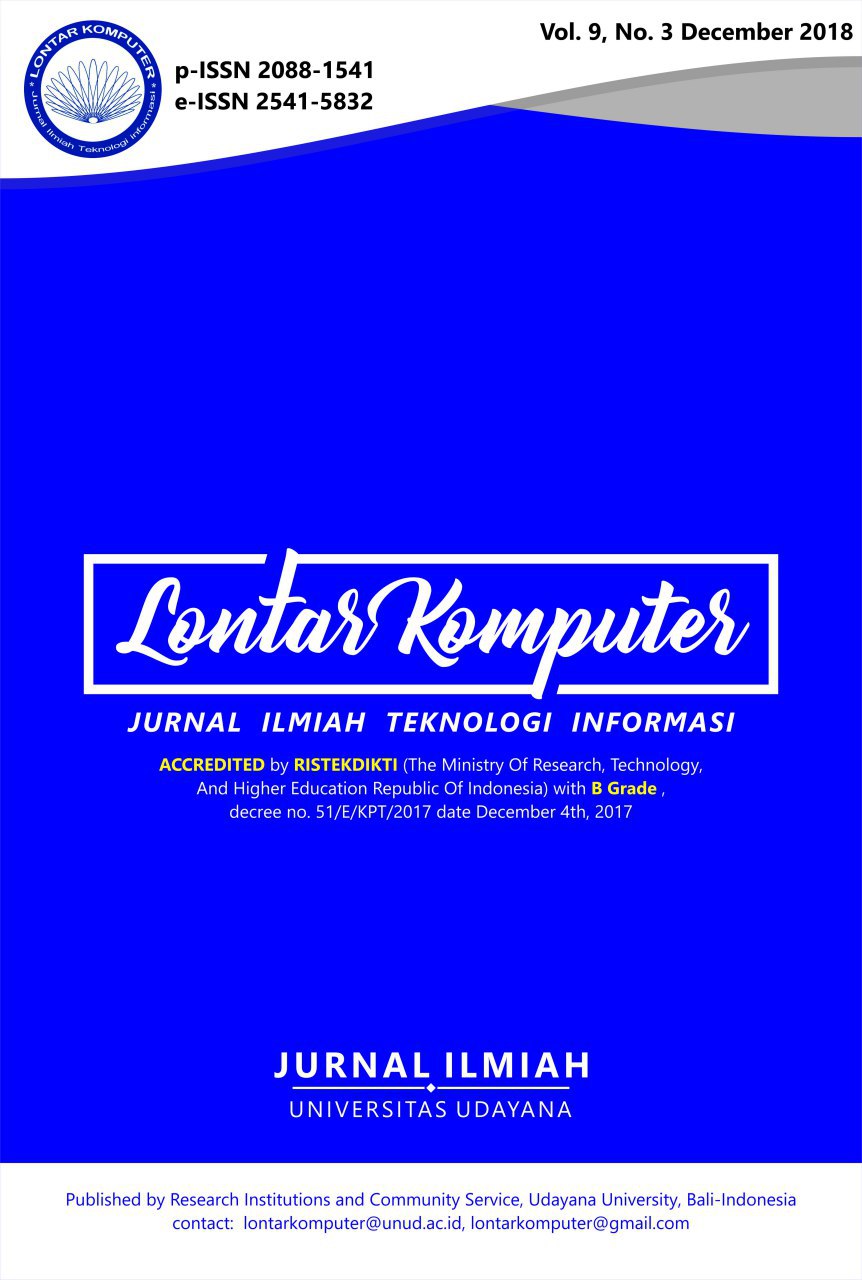Intelligent Baby Box Based on IoT to Observe Room Temperature and Baby Crying
Abstract
Internet of Things (IoT) connects a global infrastructure in communities so they can take benefit of advanced services, by connecting objects (things) both physical and virtual with the Internet so that objects can communicate each other. The object of this study is a baby box to control the baby’s condition. When the baby cries too long it may cause Baby Distressed Tantrum which is the feeling of being depressed in the baby because they feel ignored. If this happens for a long time will endanger the baby's health as it is related to respiratory function and cardiac performance. The function of the baby box is to observe a baby when left without supervision. It will enable users to know if the baby is sleeping, awake or crying. Leaving a crying baby too long may have a negative effect. By applying the Internet of Things (IoT) in the design of an intelligent a baby box will help the parents and babysitter in controlling the baby if they have other activities to do. The baby box monitoring system has a dht11 temperature and humidity sensor, and a noise sensor to detect the baby crying. An esp8266 module on Wemos d1 will send data to an android smartphone and notify the user by sound or vibration.
Downloads
References
[2] J. Santos et al., “Author ’ s Accepted Manuscript An IoT-based Mobile Gateway for Intelligent Personal Assistants on Mobile Health Environments,” Journals of Network and Computer Applications, vol. 71, no. agustus 2016, pp. 194–204, 2016.
[3] D. Sasmoko and Y. A. Wicaksono, “Implementasi Penerapan Internet of Things ( IoT ) Pada Monitoring Infus Menggunakan Esp 8266 dan Web Untuk Berbagi Data,” Jurnal Ilmiah Informatika, vol. 2, no. 1, 2017.
[4] D. Sasmoko and A. Mahendra, “Rancang Bangun Sistem Pendeteksi Kebakaran Berbasis IoT Dan Sms Gateway Menggunakan Arduino,” Simetris, vol. 8, no. 2, pp. 469–476, 2017.
[5] K. sun Jin, J. L. Houston, R. Baillargeon, A. M. Groh, and G. I. Roisman, “Young infants expect an unfamiliar adult to comfort a crying baby: Evidence from a standard violation-of-expectation task and a novel infant-triggered-video task,” Cognitive Psychology, vol. 102, no. December 2017, pp. 1–20, 2018.
[6] A. Suyetno, D. Kustono, and D. A. Sudjimat, “Pneumatic control system simulation based a PLC micro in mechatronics courses,” in AIP Conference Proceedings, 2016, vol. 1778, pp. 030035-1-030035-8.
[7] A. Deva, S. Illahi, A. Bella, S. Hadiyoso, and S. Aulia, “Safety Helmet Implementation with Centralized Information System on Remote Monitoring Applications,” Lontar Komputer Jurnal Ilmiah Teknologi Inormasi, vol. 9, no. 1, 2018.
[8] P. Mandarani, “Perancangan Dan Implementasi User Interface Berbasis Web Untuk Monitoring Suhu, Kelembaban Dan Asap Pada Ruangan Berbeda Dengan Memanfaatkan Jaringan Local Area Network,” Jurnal TEKNOIF, vol. 2, no. 2, pp. 37–42, 2014.
[9] S. Chaudhary, V. Bhargave, S. Kulkarni, P. Puranik, and A. Shinde, “Home Automation System Using WeMos D1 Mini,” International Reseach Journal of Engineering Technology, vol. 5, no. 5, pp. 4238–4241, 2018.
[10] S. Rukhmode, G. Vyavhare, S. Banot, and A. Narad, “IOT Based Agriculture Monitoring System Using Wemos,” in International Conference On Emanations in Modern Engineering Science and Management, 2017, no. March, pp. 14–19.
[11] K. N. Khamil, S. I. A. Rahman, and M. Gambilok, “Babycare alert system for prevention of child left in a parked vehicle,” ARPN Journal of Engineering and Applied Sciences, vol. 10, no. 22, pp. 17313–17319, 2015.
[12] O. Bamodu, L. Xia, and L. Tang, “An indoor environment monitoring system using low-cost sensor network,” in Energy Procedia, 2017, vol. 141, pp. 660–666.
[13] R. N. Naik, P. S. N. Reddy, S. N. Kishore, and K. T. Kumar Reddy, “Arduino Based LPG gas Monitoring & Automatic Cylinder booking with Alert System,” IOSR Journal of Electronics and Communication Engineering, vol. 11, no. 04, pp. 06-12, 2016.
[14] P. S. Lalwan, M. K. Khurana, S. J. Khandare, O. U. R. Ansari, and S. B. Pokle, “IoT Based Industrial Parameters Monitoring and Alarming System using Arduino - A Novel Approach,” International Journal of Engineering Science and Computing, vol. 8, no. 4, pp. 17305–17308, 2018.
[15] S. Rodríguez, T. Gualotuña, and C. Grilo, “A System for the Monitoring and Predicting of Data in Precision Agriculture in a Rose Greenhouse Based on Wireless Sensor Networks,” Procedia Computer Science, vol. 121, no. 8–10 November 2017, pp. 306–313, 2017.
The Authors submitting a manuscript do so on the understanding that if accepted for publication, the copyright of the article shall be assigned to Jurnal Lontar Komputer as the publisher of the journal. Copyright encompasses exclusive rights to reproduce and deliver the article in all forms and media, as well as translations. The reproduction of any part of this journal (printed or online) will be allowed only with written permission from Jurnal Lontar Komputer. The Editorial Board of Jurnal Lontar Komputer makes every effort to ensure that no wrong or misleading data, opinions, or statements be published in the journal.
 This work is licensed under a Creative Commons Attribution 4.0 International License.
This work is licensed under a Creative Commons Attribution 4.0 International License.























